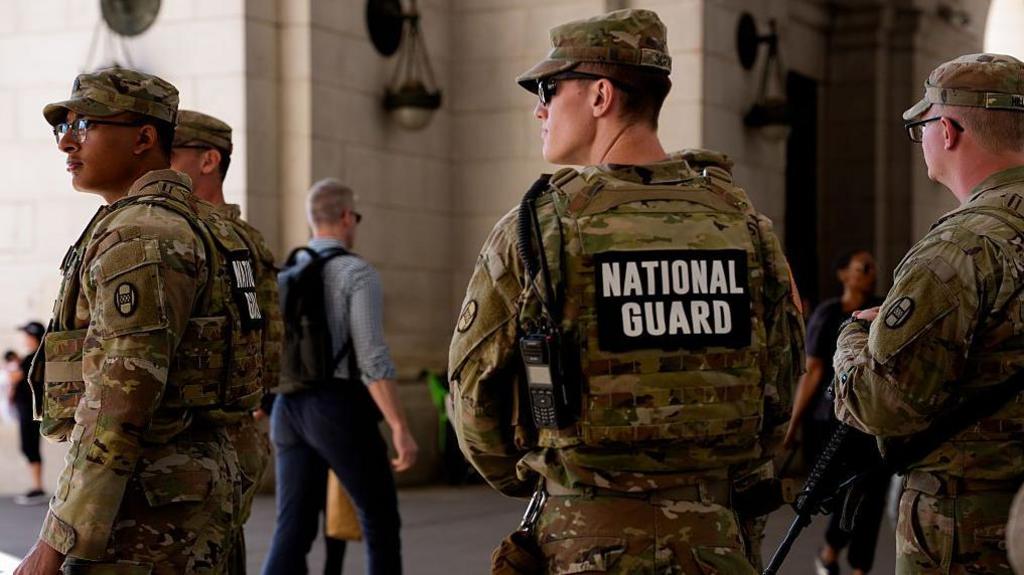“`html
President Donald Trump’s deployment of the National Guard to several U.S. cities has prompted legal challenges from state and local authorities.
Mr. Trump asserts that the use of federal troops is necessary to quell violence in cities governed by Democrats, combat crime, and bolster his deportation efforts.
However, numerous Democratic governors have resisted these deployments, deeming them unnecessary and potentially escalating tensions.
Illinois filed a lawsuit Monday seeking a judge’s injunction to prevent the deployment of troops to Chicago, while a federal judge on Sunday temporarily blocked the deployment of National Guard members from Texas and California to Portland, Oregon.
As these legal disputes unfold, here’s what to know about the National Guard:
The National Guard primarily comprises state-based troops, typically responding to situations such as natural disasters or large-scale protests.
Each of the 50 U.S. states, the District of Columbia, and the territories of Guam, Puerto Rico, and the U.S. Virgin Islands maintain their own National Guard contingent. These troops can also be deployed internationally, with some units specializing in wildfire suppression or border security.
While the National Guard ultimately reports to the Department of Defense, and the president can federalize troops under certain circumstances, requests for their support typically originate at the local level.
The governor of a state initiates the activation of National Guard troops during an emergency and can request additional assistance from the president or other states.
National Guard troops, however, have limited authority. They do not enforce laws or conduct arrests, seizures, or searches. Furthermore, the Posse Comitatus Act restricts the federal government’s power to use military force for domestic matters.
Mr. Trump has made several attempts to circumvent the standard process for deploying the National Guard.
In June, he assumed control of the California National Guard to address protests against immigration raids in Los Angeles, despite objections from California Governor Gavin Newsom. California subsequently filed two lawsuits against the Trump administration.
One lawsuit challenged Mr. Trump’s seizure of the National Guard, but an appeals court ultimately ruled in favor of the president. In a second lawsuit, a federal judge determined that Mr. Trump’s use of National Guard troops in Los Angeles violated the Posse Comitatus Act.
This summer, hundreds of National Guard troops were deployed to Washington, D.C., due to what Mr. Trump termed a “situation of complete and total lawlessness,” citing homelessness and crime rates as justification.
Mr. Trump has now authorized the deployment of 300 National Guard troops to Chicago following immigration protests, particularly near detention facilities. Governor JB Pritzker, a Democrat, has alleged that Mr. Trump is attempting to “manufacture a crisis” and has filed a lawsuit.
This week, Mr. Trump sought to deploy the National Guard to Portland, Oregon, before a federal judge temporarily blocked the action late Sunday night.
A lesser-known provision of U.S. military law governs the president’s authority to deploy the National Guard independently. However, presidents have rarely invoked it until now.
10 U.S. Code § 12406 permits the president to call National Guard troops from any state into service if the U.S. is “invaded or is in danger of invasion by a foreign nation,” or “there is a rebellion or danger of a rebellion” against the U.S. government.
Mr. Trump invoked this law to federalize 2,000 National Guard troops in June to support ICE missions.
Defense Secretary Pete Hegseth also cited the law in a memo deploying 200 members of the Oregon National Guard into federal service on September 28.
“We’re very confident in the president’s legal authority to do this,” White House press secretary Karoline Leavitt told reporters on October 6. “And we’re very confident we will win on the merits of the law.”
Mr. Trump is again seeking to utilize the National Guard to respond to demonstrations, following protests near an ICE building in Portland over the weekend.
Federal officers, including those from the Department of Homeland Security and Customs and Border Protection, clashed with demonstrators who opposed Mr. Trump’s mass deportation initiative.
The Portland Police Bureau reported that it arrested two individuals on October 4 who engaged “in aggressive behavior toward each other in the street” and refused to comply with orders. One person was found to be in possession of bear spray and a collapsible baton.
Oregon Public Broadcasting reported that federal law enforcement deployed tear gas and smoke canisters to disperse the protest and made several arrests.
Mr. Trump has claimed that the city is “burning down,” but Oregon Governor Tina Kotek, a Democrat, stated that “there is no insurrection in Portland, no threat to national security.”
The Trump administration has moved to send 200 California National Guard troops to neighboring Oregon in response to the protests.
However, U.S. District Judge Karin Immergut, a Trump appointee during his first term, has temporarily blocked his action in a pair of consecutive rulings.
On Saturday, Judge Immergut blocked Mr. Trump from federalizing the Oregon National Guard. “This is a nation of constitutional law, not martial law,” she wrote in her ruling.
The following day, she issued a temporary restraining order against him deploying California’s National Guard in Portland instead.
The Trump administration is expected to appeal.
Despite the warm words, Canada remains the only G7 country not to have reached a trade deal with Trump this year.
There were delays at a number of US airports on Monday as officials said the government shutdown is affecting air traffic control staffing.
Trump said he was mulling using the act to send the military to Portland, which he argues has been overrun by left-wing “domestic terrorists”.
There is a chance of a deal that will end the killing and destruction in Gaza and return the Israeli hostages, living and dead, to their families.
Officials say no breakthrough is expected on trade, but the Canadian prime minister is under domestic pressure to secure some form of relief.
“`

